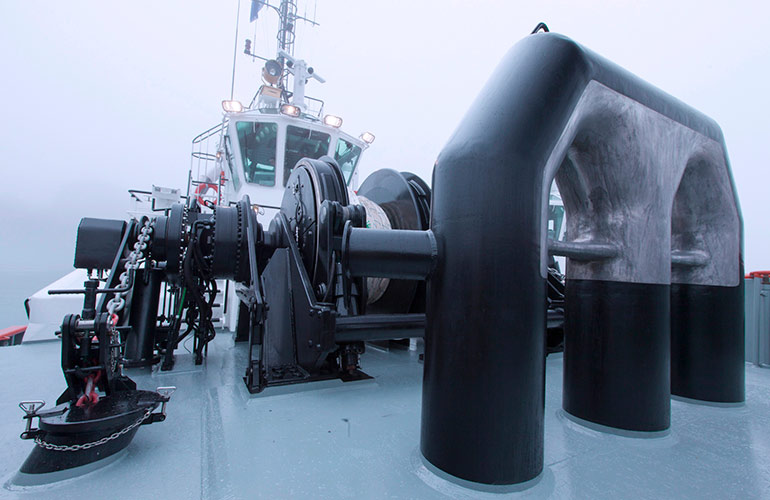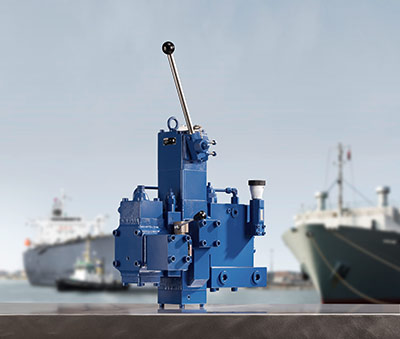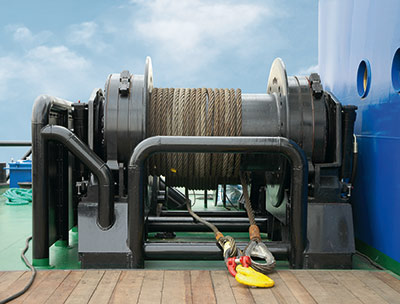Winches are used for many applications on vessels both large and small, such as anchor hoisting, mooring of the vessel, and subsequent holding of the ship against the quay. To this end, Bosch Rexroth introduced the HIWCB, a control block developed specifically for high-pressure hydraulic winches, intended for deck mounting. Its modular design enables interoperability with almost any type of winch.

Winch systems on ships are used to wind up or wind out cables of wires when anchoring ships, depositing cargo on the bottom of the sea and more. Hydraulic control blocks from Rexroth ensure safety and reliability in these systems.
The new control blocks for high-pressure hydraulic marine winches build on the developments underlying Rexroth’s existing control blocks. What sets them apart is that they are entirely assembled from standard components. In other words: because they employ proven techniques and technologies, reliability is guaranteed. This is further underlined by the fact that these blocks come from a production line which is also used to manufacture products for the mobile industry. All components are carefully documented, and parameters such as tightening torques are measured, evaluated and documented. The incidence of component failure in the field is reduced to a minimum by this approach. And of course, standard components are less expensive than non-standard variants.
What makes the HICWB unique is its modular design, which enables it to be combined with virtually any winch. This enables the vessel’s owner to hold fewer spare control blocks and offers more options for dealing with changes. This is an improvement over control blocks designed specifically for a certain application or winch. Moreover, the new blocks can be combined with both axial and radial piston motors, and with their light weight of just 44 kg, they can even be directly motor-mounted.
In addition, each complete control block undergoes a specific treatment for maximum resistance to the extreme conditions offshore. The blocks themselves are galvanized and chrome-plated, and stainless steel is used for external moving parts such as the control lever and bushes. All adjustment elements have weatherproof covers. And as a final protective barrier, a triple coating is applied in layers of each 80 µm thickness.

The modular HIWCB control block for high-pressure hydraulic winches is intended for deck mounting, and can operate with almost any type of winch.
Besides the required standard functions like counterbalance, relief and anti-cavitation valves, these lightweight and compact control blocks offer a range of additional features. To start with, they can proportionally control the winches or capstans used to raise or lower the anchor. The so-called anchor break-off function of the block, in combination with a variable displacement motor, enables the anchor to be broken free in a controlled manner. A three-position hand lever valve is used for this function: in the break-off mode, up to 1.5 times the maximum rated load is permitted. The second position of the valve allows the operator to select minimum speed (which can be pre-set) at maximum rated load, followed by maximum speed with minimum load at the third valve position.
A second important feature of the control block lies in the ability to maintain a constant tension on the mooring lines when the vessel is berthed. When the mooring lines slacken due to vertical movement of the vessel, e.g. during tide, wave motion or loading/unloading, the winches will wind in to maintain line tension. When the lines are tightened by vertical movement in the opposite direction, the winches will pay out line. The system’s high responsiveness means that tension in the lines remains constant, avoiding overload and shock forces, and keeping the vessel firmly and securely moored against the quay.

A closeup look at a typical winch system used onboard a ship.
Lastly, a number of safety features are integrated into the control blocks. An extreme situation can potentially occur when the hydraulic supply is cut off (for whatever reason) to a winch holding a suspended load, and without a brake applied. Oil can then leak via the motor drain circuit back to the tank, resulting in insufficient hydraulic pressure to continue holding the load. Ultimately, the motor will cavitate, and the load will drop uncontrollably.
To ensure a safe situation even in cases such as this, an extra valve is incorporated that responds to falling pressure by holding the oil in the motor, and blocking leakage to the tank. The motor will slow down, but will not cavitate, and the holding power remains assured.
Integrating the various features into the control block has made it possible to assemble a block that is highly compact. Not only does it require minimal space on deck, but it also simplifies the integration of functionality in the installation, since it requires considerably less piping, and with fewer external couplings, the risk of leakage is even further reduced. This approach also drives down maintenance costs over the long term.
Bosch Rexroth
www.boschrexroth-us.com
Filed Under: Fluid Power World Magazine Articles, Valves & Manifolds